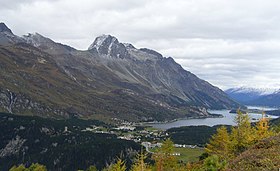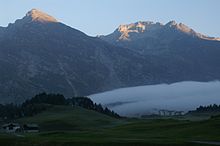Maloja
| Maloja | ||
|---|---|---|
| State : |
|
|
| Canton : |
|
|
| Region : | Maloja | |
| Political community : | Bregaglia | |
| Postal code : | 7516 | |
| Coordinates : | 773 574 / 141401 | |
| Height : | 1809 m above sea level M. | |
| Residents: | 310 | |
|
Maloja with Belvedere tower and Piz Lagrev |
||
| map | ||
|
|
||
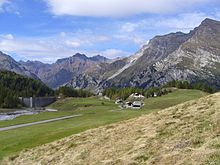
Maloja ( Romansh and Lombard ) is a village on the Malojapass between the Upper Engadine and Bergell in the Swiss canton of Graubünden . Politically it belongs to the municipality of Bregaglia in Bergell, part of the Maloja region , but geographically to the Upper Engadin. The town has around 300 inhabitants and has its own primary school, where lessons are held in two languages (Italian and German).
geography

The area around Maloja is geographically, geologically and botanically one of the most interesting areas in the Alps. Surrounded by high mountains of the main Alpine ridge, a chain of lakes stretches from the northeast through the Engadine plateau to the Maloja pass at an altitude of 1,815 m. The southernmost of these lakes, the Silsersee, is located directly on the outskirts of Maloja .
The river En / Inn , which rises in Maloja , may have given the Engiadina / Engadin landscape its name; For more information on the etymology of «Engadin», see the article there. If this derivation of the name is correct, the valley name Engadin / Engiadina could indicate that the upper reaches of the Inn River has always been called this way. Even if in the past the opinion was occasionally taken that the Inn rises near the Adige on the Reschen , since the 16th century at the latest, the origin has been uniformly seen in the area of the lakes on the Malojapass .
In addition to the core town, Maloja includes the villages and farms Capolago, Cresta, La Motta, Orden and Pila.
traffic
At the southern exit of the village, the road leads over the Malojapass 200 steep meters down into Bergell, a south-west facing valley, the road of which leads after approx. 30 kilometers into the Italian town of Chiavenna , which is only 300 m high . Conversely, you drive from Italy via Chiavenna through the Bergell up to the Malojapass , here the post bus also runs regularly .
From the north-east, Maloja can be reached with the Rhaetian Railway over the Albula Pass (to St. Moritz ), from there by post bus, also regularly. Coming from the north by car, one of the paths leads over the Julier Pass via Silvaplana .
To the south, the Murettopass connects Maloja with Valmalenco and Sondrio in Valtellina . The transition lost its importance in the 19th century, but continued to play a role as a smuggler's path for a long time. Today it is used as a footpath by hikers and mountain bikers.
On the other side of the valley, a hiking trail leads over the Lunghin pass to the Septimer and to Bivio .
Surname
The name Maloja goes back to the name Maloggia , which comes from shepherds from the south-east neighboring Valtellina and means " alder forest " (the alpine type of alder is called "Malös" or "Marös"). In 1244 the name Malongum is recorded for the place , in 1275 Malodia . In 1947 it was decided to officially use the name Maloja instead of Maloggia . In the Italian-speaking village, however, the name Maloggia is still common next to Maloia . The Romansh name is Malögia .
history
The earliest finds indicate that in the area around Maloja there was already about 2000 BC. A people who lived from hunting. Other finds, dated around 500 years later, suggest that they were people with cultures that are otherwise known in the areas of present-day Hungary and Slovakia . The main testimonies are coin finds , tub graves and ornamental stones. Before the Romans, the area was probably settled by the Rigus people.
Romans
From the time of the Romans , the important function of Malojas is proven by its location on the pass road. Roman traces can still be found on the footpath from Maloja to Cavril . Other passes in the area that have been used as crossings since the earliest historical times are the aforementioned Julier (northeast of Maloja), the Splügen (west) and two passes that can only be negotiated on foot today: to the west, from Val Maroz Ascending towards Bivio, the Septimerpass, which, seen from Maloja, lies behind the summit of Piz Lunghin , and southeast of the Muretto, branching off from Val Forno towards Valtellina.
Smuggling along these routes and over these passes was later of some importance in terms of economic, political and cultural history.
Beginning of modern times
From the 15th century, Maloja was made accessible to summer residents by the farmers of Stampa (Bergell). The original construction can still be seen in the surrounding hamlets of Cresta, Cà de Maté, Orden sopra / Orden dent and Pila.
18th century
At the end of the 18th century, the population of the area suffered the effects of the Napoleonic wars, when the French and Austrian military alternated with occupations, devastation and cattle stealing. For the farmers of Bergell, the retreat up to Maloja was an attempt to survive the time.
Founding period

At the end of the 19th century, spa tourism should also move into Maloja. Count Camille de Renesse had the vision of making Maloja the "Monte Carlo of the Alps". So a resort for the upscale aristocracy was planned. From 1882 to 1884 a. a. build the Palace Hotel , which was used as a rest home for children and young people until the beginning of 2008. Since 2009 it has been a castle hotel again.
The former Anglican, now Reformed village church and the Torre Belvedere on the pass also date from the founding period . The tower is now owned by pro natura . The Berghotel Kulm had its own post office until 1880. Between 1882 and 1900 there were 16,594 mail travelers on the Malojaroute, between 1930 and 1952 there were 218,884.
The Torre Belvedere
Camille de Renesse , who built a lot in Maloja in the early days
Second World War
During the Second World War , important events of the anti-fascist resistance took place around Maloja , which has received increasing scientific attention in recent years.
Also during the Second World War , the Maloja barrier was built in the upper part of the Malojapassstrasse .
art
Segantini
The most famous painter in the region today is Giovanni Segantini , he is considered the Engadin painter. He and his family spent the last five years of his life in Maloja.
In and around Maloja, various excursions can be undertaken in the footsteps of this painter: a visit to the «Casa Segantini», the Segantini studio (both located in the village) and a promenade, the «Sentiero Segantini», with individual picture stations on one The hiking trail leads into the Orden side valley.
Giacometti
One of his master students was Giovanni Giacometti , the father of Alberto Giacometti , both of whom came from Stampa in Bergell.
Other artists
The artist Elvezia Michel-Baldini , who lived and worked in Borgonovo in Bergell , obtained the linen for her art weaving from her own flax cultivation in the hamlet of Pila at the foot of the Lunghin near Maloja.
Installation Culur on the retaining wall
In 1997, an open-air installation made up of nine colored Culur columns by Gottfried Honegger was inaugurated in the Seitental Orden . It is prominently placed in the area and creates a connection upstream across the Orlegna between the retaining wall and the property of the Salecina Foundation , the last inhabited property in the Orden side valley on the Orlegna Bridge on the way to the Forno Glacier.
Attractions
Many sights and monuments in Maloja date from the Wilhelminian era:
- Chiesa bianca: opened around 1885 as the first Anglican church, catholic church from 1890–1967, since then profaned and used sporadically for cultural events.
- former Anglican church, built 1888–1889, today the Maloja Reformed Church
- Hotel Palace, now the Maloja Palace
- House Perico-Baldini
- Hotel Schweizerhaus
- Segantini house
- Villa La Motta
The Pro Castellis association has made the main Maloja Kulm plant (A 7678) at the Maloja restricted area accessible to the public as the “Museo Fortezza Maloja” museum.
View across the Malojapass to the Val Maroz, in the foreground Salecina
Lake Sils with Kursaal Maloja , around 1906, today Maloja Palace
Meteorological phenomenon: the «Maloja snake»
Mostly on autumn mornings a fog "snake" forms when the level of condensation is low enough to transform the rising, moist air at the height of Maloja into clouds or fog. It is a natural spectacle in which bright sunshine can already be above the "snake" (see photo on the right). The specialty of the snake is that it does not lie quietly in the valley, but rather crawls down to the west over the Malojapass. Depending on the wind and weather conditions, the phenomenon can be over quickly. There is also a film about this by the German mountain filmmaker Arnold Fanck : The Maloja Cloud Phenomenon (1924).
geology
The area around Maloja has numerous geological features. So the Lägh found near da Cavloc (Cavloc Lake) in Fornotal (Valley of the Fornogletschers ) green rocks that were originally in the ocean between the African continental plate have formed and European continental plates. Over the shifts have these rocks transformed ( metamorphism ), in Fornotal is a result about the famous andalusite - slate .
Andalusite slate is one of those rocks that come about through contact metamorphosis, also known as thermometamorphism, because the process takes place with increasing temperatures. It is also important to keep the pressure constant. The original rock is changed grain by grain (recrystallization). If some areas were still porous, they will now disappear. This process is called contact metamorphosis because the individual grains come into direct contact with one another. The products of such processes can be recognized by the fact that new minerals sprout outwards, which can be speckled, sheaf-like or knot-like. There are many such finds to be made in the Forno valley.
water
For a mountain village, and especially for a mountain pass village, Maloja has an unusually large amount to do with water:
- On the one hand, it is located on Lake Sils , which serves as a reservoir for the community's drinking water treatment.
- Second, the Inn , one of the great rivers of the European continent, has its source in the Lunghinsee (Lägh dal Lunghin), which comes down in a waterfall on the eastern slope of Piz Lunghin (near the hamlet of Pila).
- Thirdly, there is the peculiarity that the glacier river «Orlegna» has nothing to do geographically with the Inn (see below on the watershed), but, although only one kilometer from the start of the river Inn, turns south-west towards Italy. At this point, a flood retention barrier was built in the mid-1980s, which serves exclusively to hold back floods or debris. The river bed, which is mostly accessible in Orden and which makes up the retention basin today, and above all the protective wall, has already benefited the villages in Bergell a lot, because in 1987 they were spared the consequences of a dangerously strong flood.
- Fourth, there are two smaller lakes, the Lägh da Cavloc (Cavloccia Lake) and the Lägh da Bitabergh (Bitabergasee), both popular excursion destinations.
In late autumn, water is also used to a large extent for artificial snow production (snowmaking). Here, water from the municipality of Stampa / Maloja is separated with a system separator. In this way the water can flow back from the snowmaking pipe.
European watershed point on the Lunghin Pass
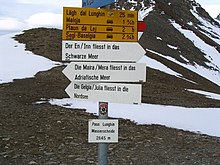
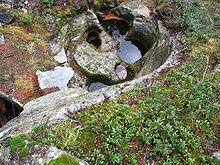
There is a watershed point at the Lunghin pass near Maloja - it is the intersection of three important river systems in Europe:
- the Inn flows over the Danube into the Black Sea ,
- the Julia over the Rhine into the North Sea and thus into the Atlantic ,
- the Maira over the Po into the Adriatic Sea and thus into the Mediterranean .
tourism
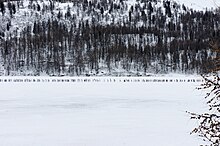
Sports
Maloja is a hiking, touring and climbing area of the highest order. Perseverance is rewarded with impressive scenic views. On a well-maintained circular route through a nature reserve, the traces of retreat of the glaciers of the last Ice Age can be marveled at, there are more glacier pots here than anywhere else in Europe.
The Silsersee offers the best surfing and sailing conditions in summer.
In winter, Maloja is the starting point for numerous cross-country ski trails and the traditional starting point for the Engadin Skimarathon . a. leads over the frozen Silsersee , the goal is S-chanf after 42 km . The ski lift on Piz Aela transports alpine skiers to an altitude of almost 2000 m, and after snowfall the mountain turns into a powder snow paradise for snowboarders too.
Educational work
On site in Maloja, visitors can learn interesting facts about the consequences of the continental collision 90 million years ago for the geology and geomorphology of the area in the permanent exhibition «Maloja landscape history». The exhibition was designed by the Pro Natura Association and can be seen in the Torre Belvedere on the edge of the village above the start of the pass road.
The Salecina holiday and education center is known beyond Switzerland .
Personalities
- Gottardo Guido Segantini (born May 25, 1882 in Pusiano , † June 16, 1974 in Maloja), Giovanni Segantini's son, painter, engraver
- Mario Segantini (born March 31, 1885 in Milan , † February 1916 in Maloja), sculptor, painter and etcher. Son of Giovanni
- Vico Rigassi (born December 7, 1905 in Stampa ; † August 6, 1983 in Maloja), sports journalist on the radio, official spokesman for the cycling world championships
literature
- Adolf Collenberg: Maloja. In: Historical Lexicon of Switzerland . 2016 .
- Peter Heitzmann: Granite massif in the Gneiss Mountains . In: Mountains. The international magazine of the mountains. No. 29, April 1988 ( Topic Bergell ), pp. 46-49, ISSN 0947-5958
- Malojastrasse: Upper Engadin – Bergell, St. Moritz – Maloja – Castasegna . Bern: General Directorate of the Post, Telegraph and Telephone Administration, issues from 1946, 1950, 1960 (Volume 21 of the “Swiss Alpine Post” series, since 1932).
- Simona Martinoli u. a .: Guida d'arte della Svizzera italiana. Edited by the Society for Swiss Art History . Edizioni Casagrande, Bellinzona 2007, pp. 527-529.
- Erwin Poeschel : The art monuments of the canton of Graubünden III. The valley areas Räzünser Boden, Domleschg, Heinzenberg, Oberhalbstein, Upper and Lower Engadine (= Swiss art monuments. Volume 11). Edited by the Society for Swiss Art History GSK. Bern 1940. DNB 760079625 .
Web links
- The Maloja page on the Engadin St. Moritz website
- Centro Segantini Maloja
- Fondazione Salecina / Stiftung Salecina (self-managed holiday and conference house)
- «Culur», landscape installation in medals
- Hikes around Maloja
- Maloja on the ETHorama platform
Individual evidence
- ↑ Centro Segantini, «Maloja», archived copy ( memento of the original from July 19, 2006 in the Internet Archive ) Info: The archive link was inserted automatically and has not yet been checked. Please check the original and archive link according to the instructions and then remove this notice.
- ↑ Bernadette Conrad: A castle for me alone. ZEIT Online , March 1, 2012.
- ↑ Atelier Segantini on ETHorama
- ↑ Peter Böckli: Until the Countess' death. The drama about the hotel palace of Count de Renesse in Maloja. 10th edition. Verlag der Neue Zürcher Zeitung, Zurich 2015, p. 35, note 20.
- ^ Former Anglican Church
- ^ Hotel Palace
- ^ House Perico-Baldini
- ↑ Hotel Schweizerhaus
- ↑ Segantini House
- ↑ Atelier Segantini on ethorama.library.ethz.ch/de/node
- ↑ Villa La Motta
- ↑ News from February 21, 2006 at snowmakers.ch ( Memento from July 18, 2006 in the Internet Archive )
- ↑ Gottardo Guido Segantini. In: Sikart , accessed January 6, 2016.
- ^ Mario Segantini. In: Sikart , accessed January 6, 2016.
- ↑ Marco Marcacci: Vico Rigassi. In: Historical Lexicon of Switzerland . November 15, 2010 , accessed April 29, 2020 .
